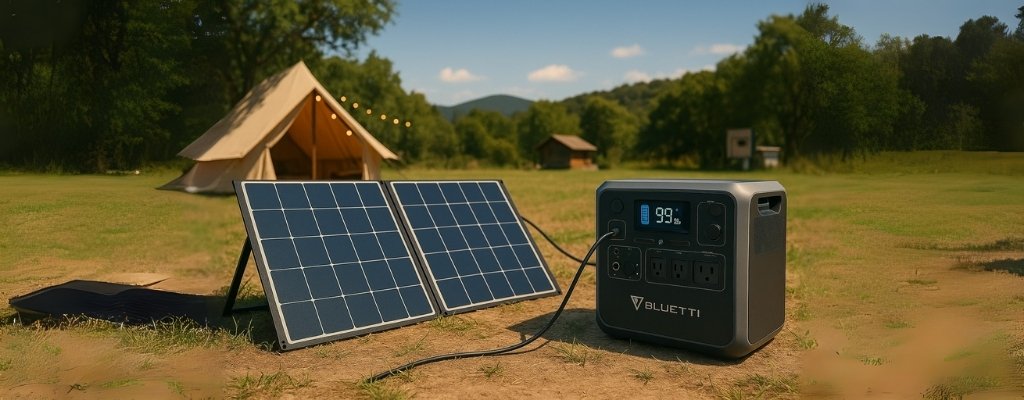
How to Connect Bluetti Solar Panels?
Thinking about going solar with your Bluetti? Connecting solar panels to your portable power station is easier than you’d think—and it doesn’t take a sparkie’s licence to get it right. Whether you're gearing up for off-grid camping or slashing your power bill at home, this guide will help you get plugged in safely and properly.
Not sure which power station is right for you?
Take the quiz!
Portable Power Station Solar Panel Basics and Compatibility
Key Specs to Check: Voltage, Current, and Wattage
If you skip this step, you risk blowing something—or getting nothing at all. Before you connect anything, you need to make sure your solar panel matches your Bluetti's requirements. Focus on these three:
- Open Circuit Voltage (Voc): Should sit comfortably within the Bluetti’s allowed input range.
- Short Circuit Current (Isc): Needs to be under the station’s max current rating.
- Total Wattage: Optimise for the unit’s built-in MPPT charge controller.
It’s a bit like matching the right trailer to your ute—you don’t want to be dragging something your rig can’t handle.
Connector Types: MC4, XT90, DC7909, and Bluetti Solar Input Connector
Most panels, whether from Bluetti or third parties, use the MC4 connector. But Bluetti power stations have different input types depending on the model—XT90, DC7909, or sometimes aviation plugs. That’s why a proper bluetti solar charging cable or MC4-to-XT90 adapter is essential. Get the match wrong, and you’ll either lose power—or worse, fry something.
Bluetti's Built-In MPPT Solar Charge Controller
The good news? You don’t need to buy a separate charge controller. Bluetti power stations have MPPT tech built in. It automatically adjusts to give you the best solar input possible—like cruise control for your panels. Just make sure you stay within the unit's voltage and current limits, and you’re golden.

Portable Power Station Setup: Connecting Bluetti and Third-Party Panels
Bluetti Branded Panels: Plug-and-Play Simplicity
If you’ve got a Bluetti panel, you’re laughing. They’re designed to work straight out of the box. Most come with everything you need, including the right connector cables. Here’s how to hook it up:
Unfold the panel and angle it to face the sun
Plug in the MC4 leads (already attached)
If needed, connect your MC4-to-XT90 adapter
Insert the adapter into the solar input port
Check the screen for incoming solar wattage
That’s it. No soldering, no guesswork—just sunshine to power in a few simple clicks.
Connecting Third-Party Panels Safely
Want to use a different brand of solar panel? Fair enough, but now you’re the one responsible for making sure specs line up. Start with the basics: make sure your panel’s Voc is within your Bluetti’s range, and check the current isn’t over the max limit. Then grab the right adapters—like MC4 to DC7909 or MC4 to XT90. A bluetti solar panel extension cable is also handy if your panel needs to sit further from your power station.
Double-check voltage and current ratings
Use proper adapters to convert MC4 to Bluetti input
Watch the polarity—mixing up positive and negative won’t end well
And for the love of solar, never plug it in while it’s still folded or partially shaded. Wait till it's laid out properly under full sun.
Series vs Parallel Connection Tips for Multiple Panels
Series:
Join the positive lead of one panel to the negative of the next. This boosts voltage while keeping current steady. Great for models that need higher input voltage, like the AC200MAX or EP500.
Parallel:
Connect all positives together and all negatives together. Voltage stays the same, current goes up. Perfect if your station’s voltage limit is low but it can handle more current.
Wrong setup here can cook your power station or leave you scratching your head with a dead panel. Check the manual, always.

Portable Power Station Solar Charging Tips and Troubleshooting
Optimise Panel Positioning and Avoid Shading
Get your angles right—point your panels north in Australia and aim for a tilt around 30–45 degrees. Even a small patch of shade across one corner can tank your output. It’s like trying to tan with half a beach towel on your back.
Use Proper Gauge Extension Cables for Longer Runs
If your panels are more than a few metres from the power station, voltage drop becomes a thing. Use thicker, low-resistance cable like a genuine bluetti solar panel extension cable. It keeps your input strong and stable, especially on big setups.

No Input Showing? Here’s What to Check
- Are your connectors fully clicked in?
- Did you use the correct adapter?
- Is there sunlight, or is your panel in shade?
- Have you exceeded voltage/current specs?
If you’re still stuck, unplug everything and start from scratch. It’s usually something simple like a loose MC4 connector or wrong polarity.


